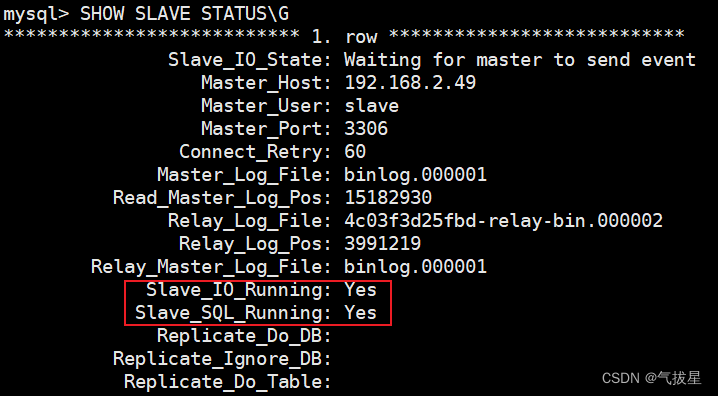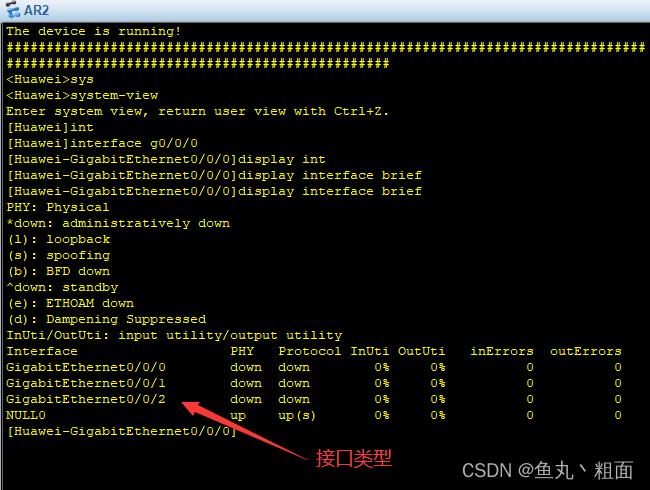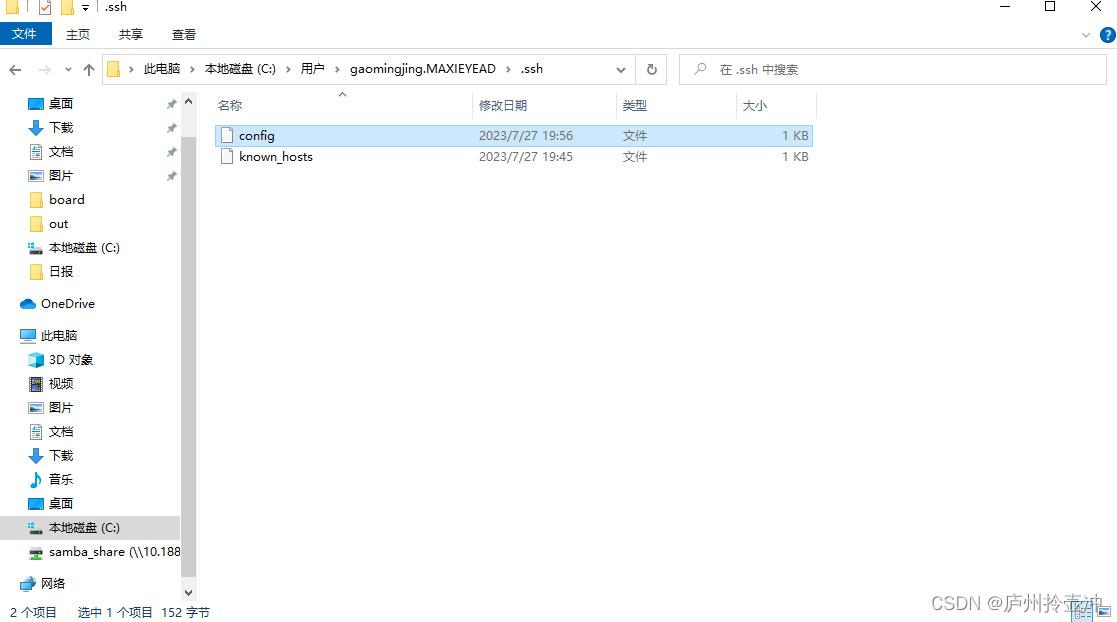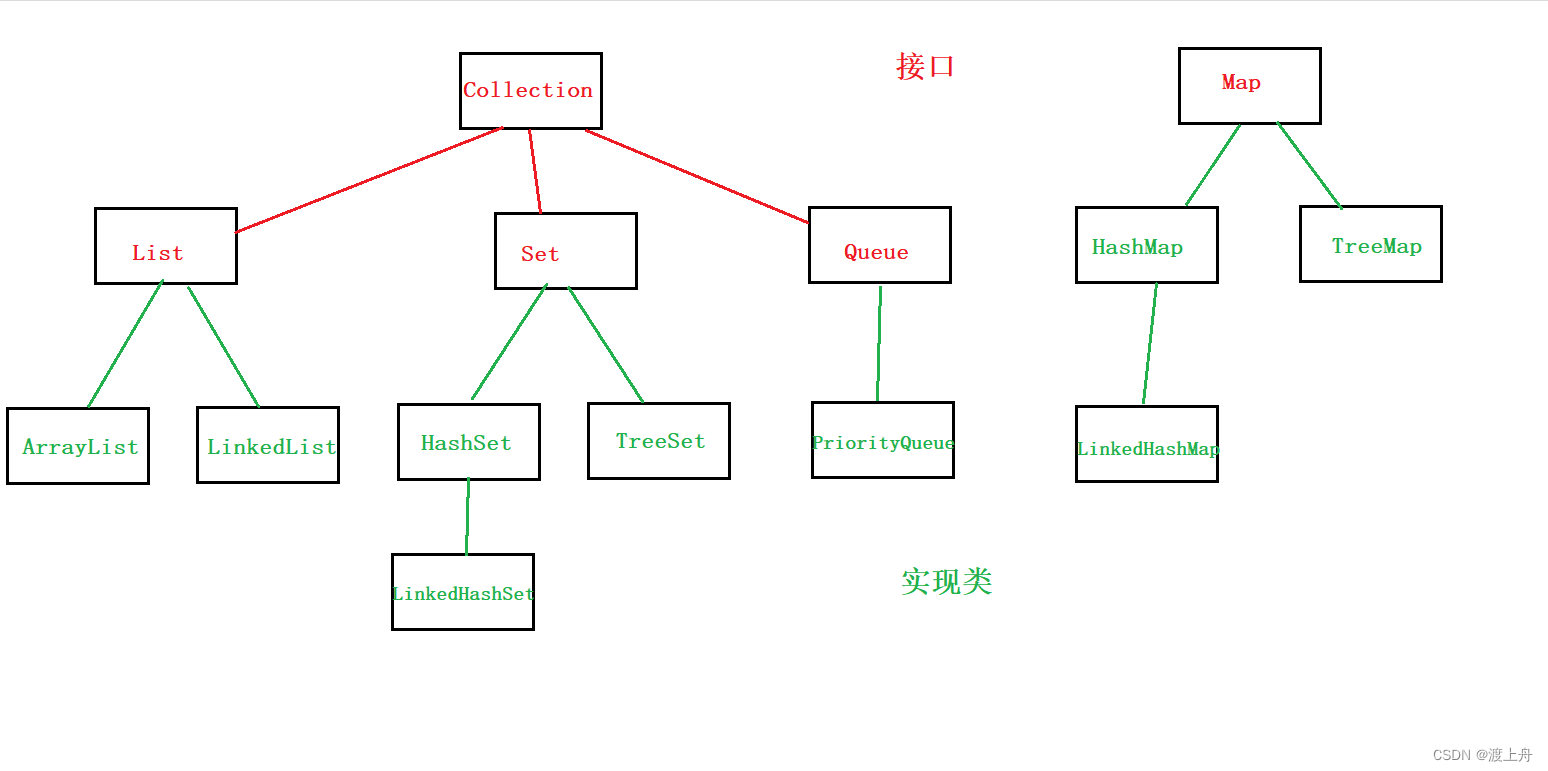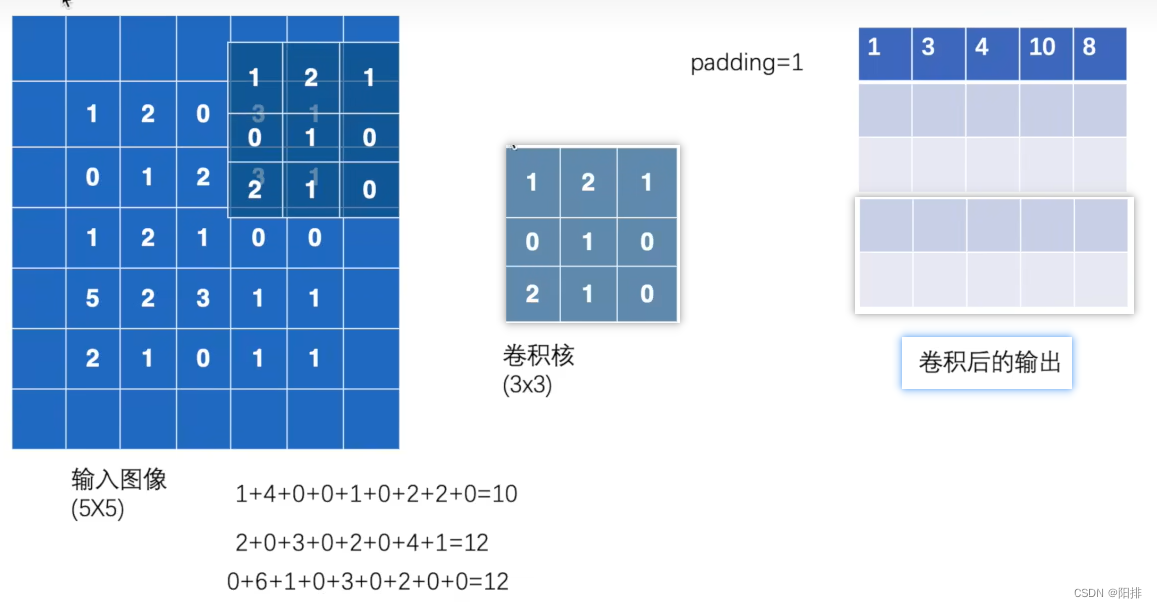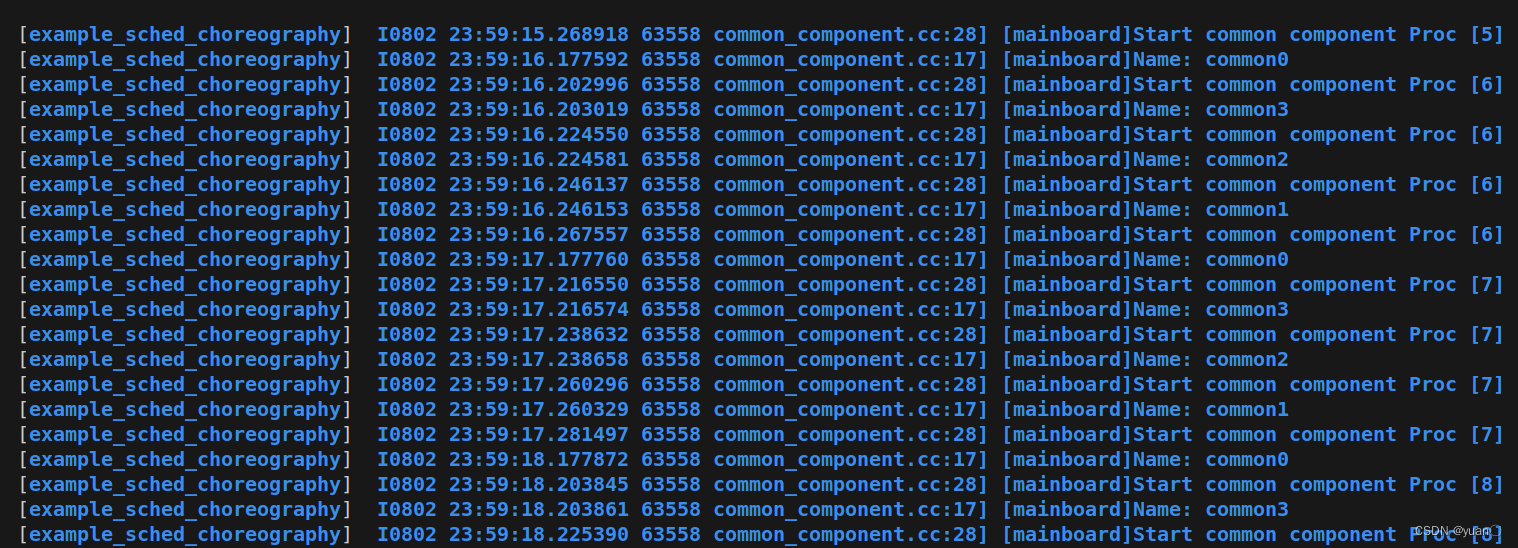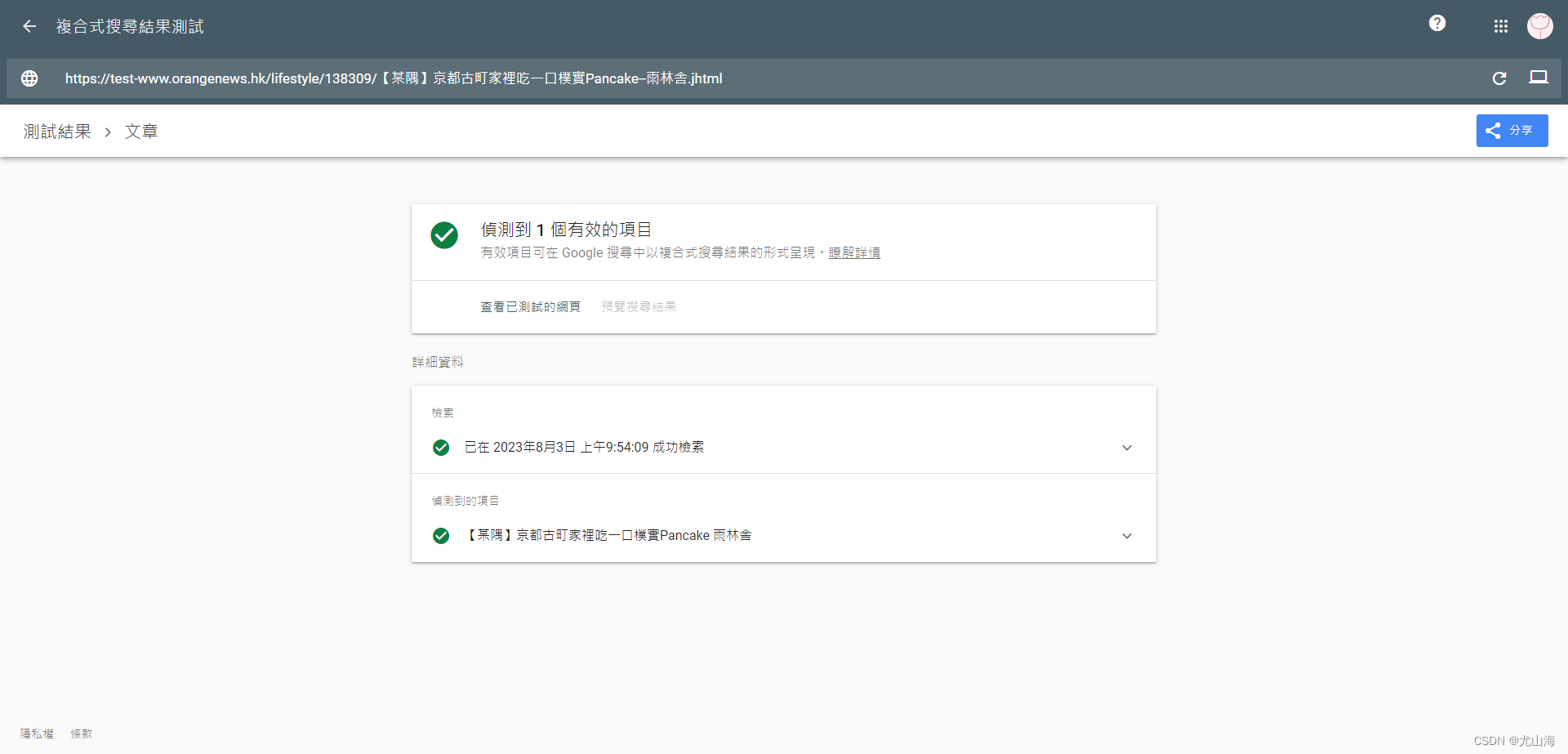目录
一、什么是带头循环双向链表?
1.特点:
2.优点:
二、实现接口
1.前置准备
1.1需要的三个文件
1.2结构体的创建和头文件的引用
2.接口实现
2.1函数创建新节点
2.2打印链表内容
2.3尾插新节点
2.4头插新节点
2.5头删节点
2.6尾删节点
2.7查找节点
2.8在指定位置前插入节点
2.9删除指定位置节点.
2.10摧毁链表
三、全部代码
1.接口头文件
2.接口实现
3.测试文件
一、什么是带头循环双向链表?
1.特点:
1.带头:有哨兵位节点,它不用存储数据。对链表进行插入删除操作时也不会影响改节点。
2.双向:组成链表的结构体中的结构体成员有数据,上一个节点的地址和下一个节点的地址
3.循环:链表的头结点存储了尾结点的地址,链表的尾结点存储了头节点的地址。
2.优点:
相比单向链表,双向循环链表的优点在于它的尾插找尾巴非常的快 因为它的头节点同时存储了上一个节点的地址,头的上一个即尾。相比无头链表,带头链表的好处在于当没有节点的时候,可以直接通过访问结构体成员的方式来增加相应的指针,而无头的话需要直接对地址进行修改,传变量的时候还需要传递二级指针 不仅不好理解,还易在实现的时候出错。
二、实现接口
1.前置准备
1.1需要的三个文件
先创建两个.c文件,再创建一个头文件,分别命名为test.c,list.c,list.h
test.c用来测试写好的接口 list.c存放实现接口的代码
list.h则存放对应函数,头文件,结构体的声明,这样在想使用链表的接口时,直接引用list.h即可,不需要引用别的头文件。
创建好的环境如图
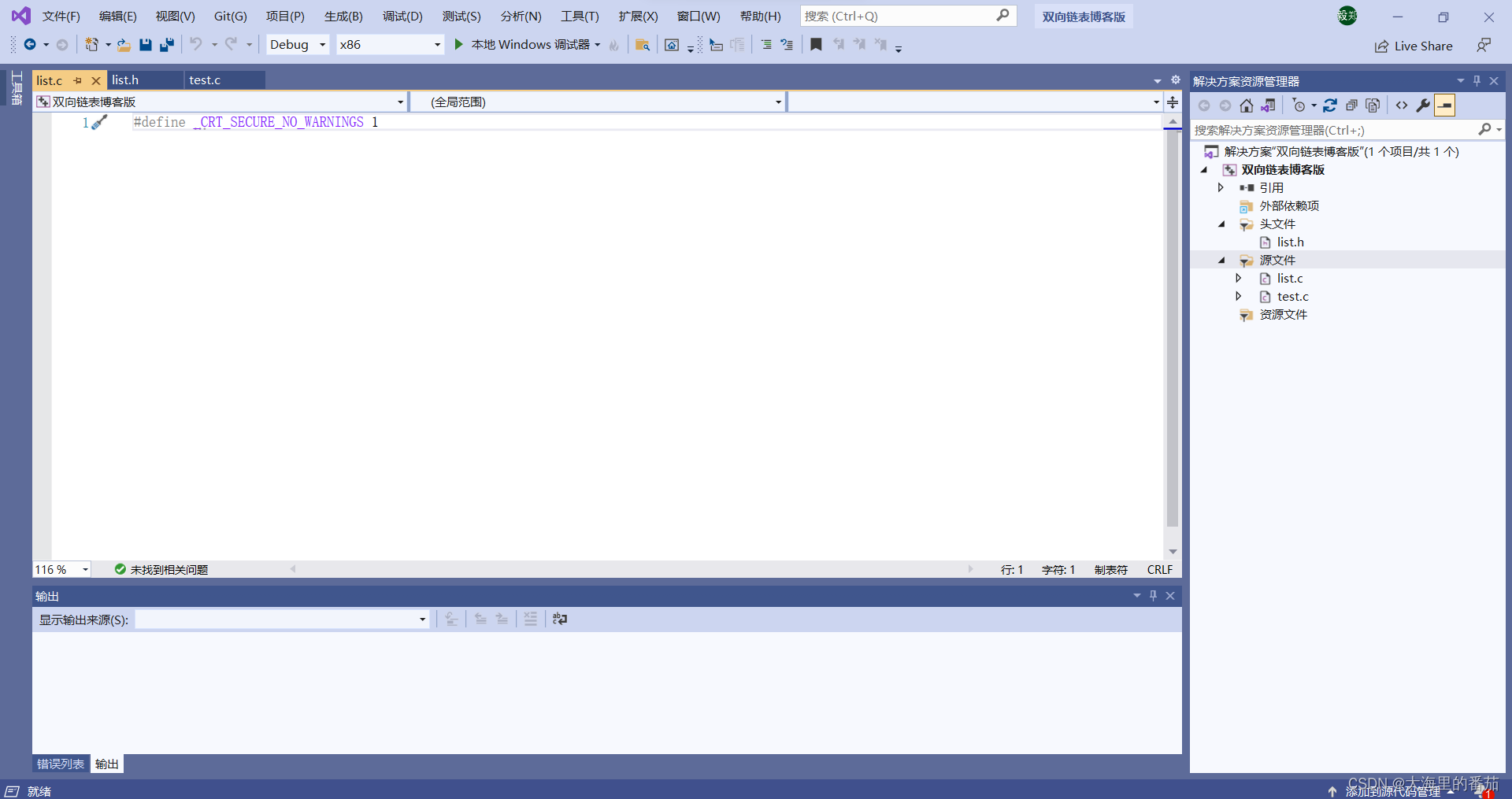
1.2结构体的创建和头文件的引用
这些内容放在list.h的文件中,到时引用就可以一条龙带走,不需要再引用别的内容
#pragma once//防止头文件二次引用
#include<stdio.h>
#include<assert.h>
#include<stdlib.h>
typedef int LTDateType;
//这样创建结构体数据类型,不仅是为了和int做区分
//也是为了到时更好的替换,想换直接把int改了就行
typedef struct listnode
{
struct listnode* prev;//存放上一个节点的地址
struct listnode* next;//存放下一个节点的地址
LTDateType data;//该节点存放的数据
}listnode;2.接口实现
2.1函数创建新节点
创建节点,虽然简单,但我们在很多操作中都会用到,因此把它单独分装成一个接口
listnode* buy_listnode(LTDateType x)
{
listnode*newnode=(listnode*)malloc(sizeof(listnode));
if (newnode == NULL)
{
perror("buy_listnode");//错误提示
exit(-1);//节点都没创建出来,直接退出程序
}
newnode->data = x;//将新节点的数据初始化成我们需要的
newnode->next = NULL;//不清楚插入的方式,先初始化成空
newnode->prev = NULL;
}2.2打印链表内容
非常经典的操作,遍历一遍链表即可,唯一需要注意的便是,哨兵节点不是链表中真正的成员,它只能算是实现链表的辅助,因此跳过哨兵节点进行打印
void print_list(listnode* phead)
{
assert(phead);//哨兵节点地址不可能为空
listnode* head = phead->next;
//哨兵位节点不存储有效数据,因此phead->next才是头节点
printf("head<=>");//纯属美观
while (head != phead)//当head和phead相等意味着已经遍历完一遍链表
{
printf("%d<=>", head->data);
head = head->next;
}
printf("\n");
}2.3尾插新节点
void list_pushback(listnode*phead,LTDateType x)
//尾插一个新节点,此节点存储x
{
listnode* newnode = buy_listnode(x);
//创建一个我们需要的新节点
listnode* tail = phead->prev;
//先找尾,尾很显然是哨兵位节点的上一个节点
tail->next = newnode;
newnode->prev = tail;
newnode->next = phead;
phead->prev = newnode;
}后面的4行代码是核心,单独在文章中解释,创建了一个新节点,要把它放到链表的末端,尾节点我们已经找到了,接下来就是链接即可
首先明确,新的尾巴是创建出来的新节点,但还没进行链接之前,尾巴还是之前的尾巴
原始链表
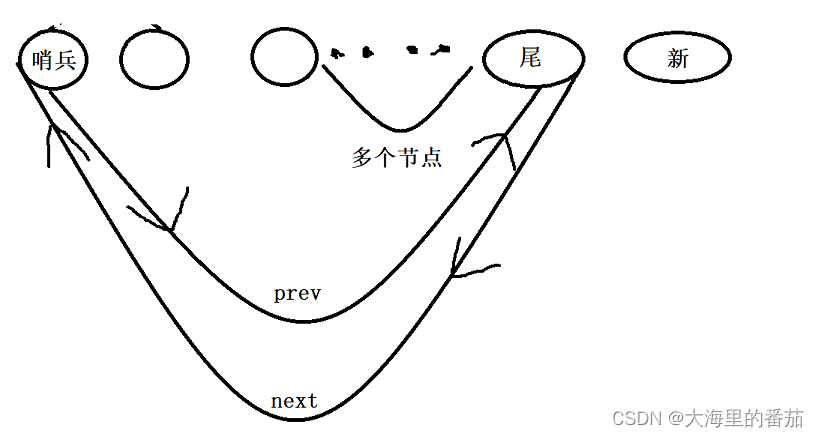
第一步:
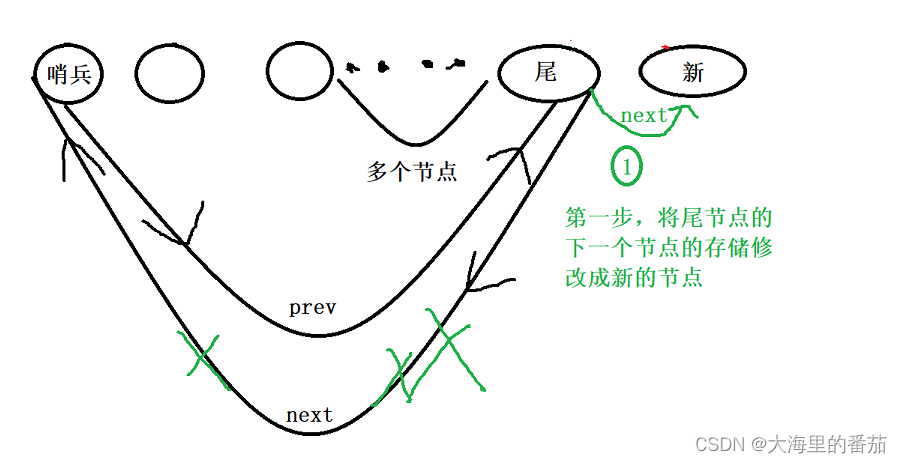
第二步:

第三步:
第四步:

测试代码:
#include"list.h"
void test1()
{
listnode* plist=NULL;
plist=init_listnode(plist);
list_pushback(plist,1);
list_pushback(plist,2);
list_pushback(plist,3);
list_pushback(plist,4);
print_list(plist);
}
int main()
{
test1();
}测试效果:

2.4头插新节点
这里我就不再画图了,自己画一遍比看别人画一万遍都来的快
void list_pushfront(listnode* phead, LTDateType x)
{
listnode* head = phead->next;//找到头节点
listnode* newnode = buy_listnode(x);//创建新节点
head->prev = newnode;
newnode->next = head;
phead->next = newnode;
newnode->prev = phead;
}测试代码:
void test2()
{
listnode* plist = NULL;
plist = init_listnode(plist);
list_pushfront(plist, 1);
list_pushfront(plist, 2);
print_list(plist);
list_pushfront(plist, 10086);
print_list(plist);
}
int main()
{
test2();
}测试效果:

2.5头删节点
需要注意的一点便是,我们删的节点不是哨兵节点,哨兵节点是不存放有效数据的,我们删除的是头节点
void list_popfront(listnode*phead)
{
assert(phead);
if (phead->next == phead)
{
printf("链表为空,操作失败\n");//为空就别删了
return;
}
listnode* head = phead->next;//找到头节点
phead->next = head->next;
head->next->prev = phead;
free(head);//链接完成,彻底删除
}测试代码:
void test3()
{
listnode* plist = NULL;
plist = init_listnode(plist);
list_pushfront(plist, 1);
list_pushfront(plist, 2);
print_list(plist);
list_pushfront(plist, 10086);
print_list(plist);
list_popfront(plist);
print_list(plist);
list_popfront(plist);
print_list(plist);
list_popfront(plist);
print_list(plist);
list_popfront(plist);
print_list(plist);
}
int main()
{
test3();
}测试效果:

2.6尾删节点
没什么好说的,和之前的一样关键点在链接上,自己画了图什么都知道
void list_popback(listnode*phead)
{
assert(phead);
if (phead->next == phead)
{
printf("链表为空,操作失败\n");//为空就别删了
return;
}
listnode* tail = phead->prev;//找到尾节点
phead->prev = tail->prev;
tail->prev->next = phead;
free(tail);
}测试代码:
void test4()
{
listnode* plist = NULL;
plist = init_listnode(plist);
list_pushfront(plist, 1);
list_pushfront(plist, 2);
list_pushfront(plist, 10086);
print_list(plist);
list_popback(plist);
print_list(plist);
list_popback(plist);
print_list(plist);
list_popback(plist);
print_list(plist);
list_popback(plist);
print_list(plist);
}
int main()
{
test4();
}测试效果:
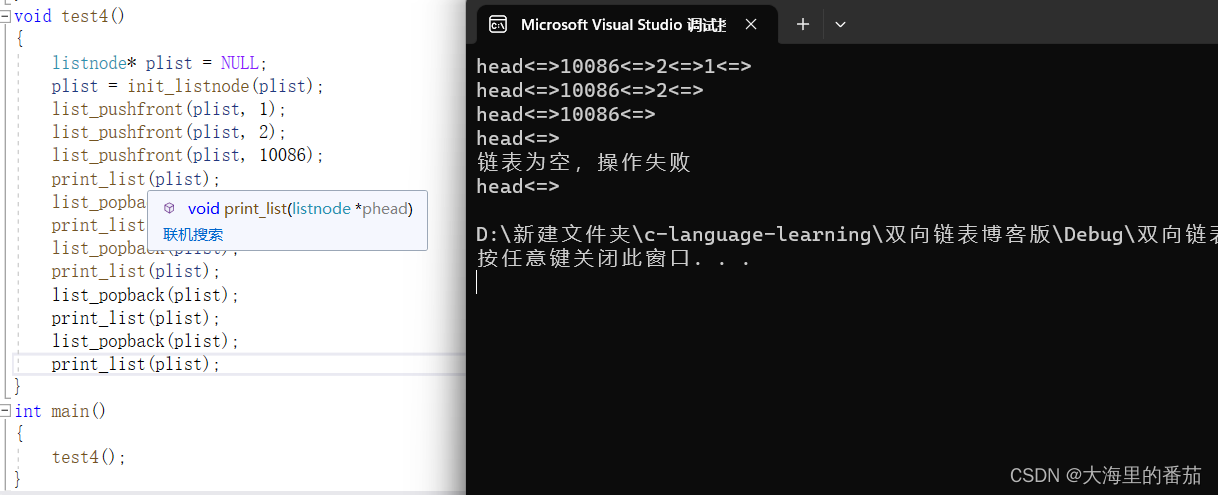
2.7查找节点
遍历一遍,找不到就返回NULL即可
listnode* list_find(listnode* phead, LTDateType x)
//哨兵节点和目标
{
assert(phead);
listnode* head = phead->next;//找到头节点
while (head!=phead)//相等意味着已经遍历完了
{
if (head->data == x)
//找到目标,直接返回
{
return head;
}
head = head->next;
}
return NULL;//遍历完还找不到,返回空指针
}2.8在指定位置前插入节点
根据目标进行链接即可
void list_insert(listnode*pos,LTDateType x)
//目标位置,和在其前面插入数据为x的节点
{
if (pos == NULL)//传空意味着没找到目标
{
printf("目标不存在,操作失败\n");
return;
}
listnode*newnode=buy_listnode(x);//创建新节点
newnode->next = pos;
newnode->prev= pos->prev;
pos->prev->next = newnode;
pos->prev = newnode;
}测试代码:
void test5()
{
listnode* plist = NULL;
plist = init_listnode(plist);
list_pushfront(plist, 1);
list_pushfront(plist, 2);
list_pushfront(plist, 10086);
print_list(plist);
listnode*pos=list_find(plist,2);
list_insert(pos, 888);//在2之前插入888
print_list(plist);
list_insert(plist->next, 666);
//在头节点前插入666,与头插效用一致
//可以在头插中复用这个函数
print_list(plist);
list_insert(plist, 520);
//在哨兵节点前插入520,与尾插效用一致
//可以在尾插中复用这个函数
print_list(plist);
}
int main()
{
test5();
}测试效果:
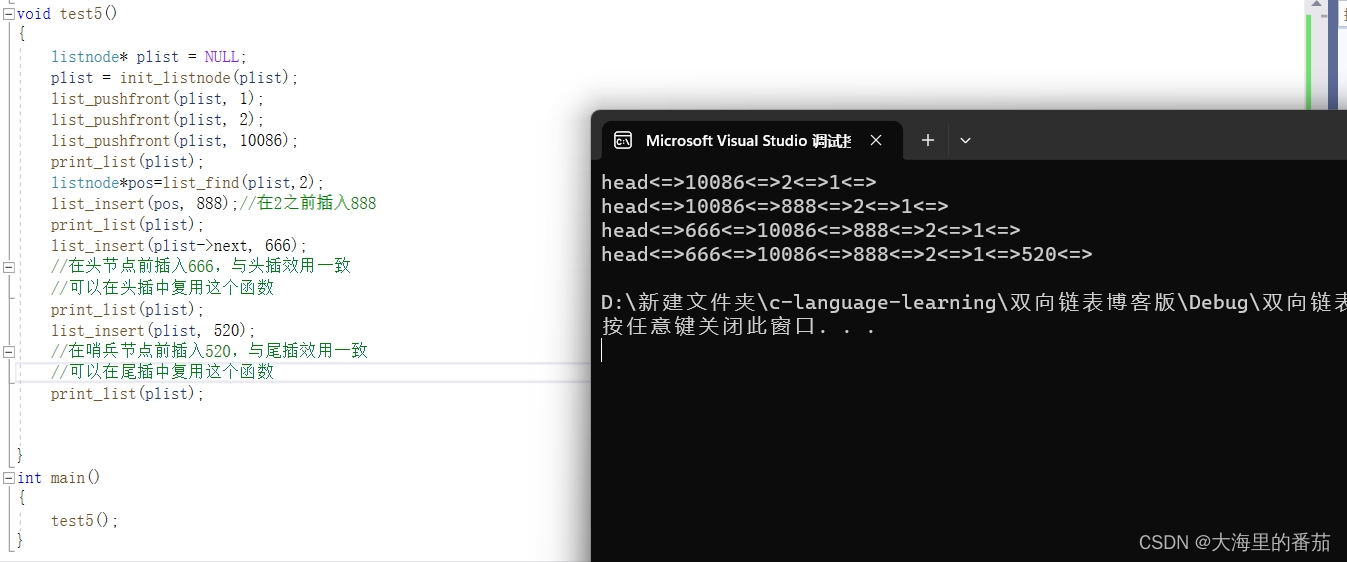
2.9删除指定位置节点.
void list_erase(listnode* pos)
{
assert(pos && pos->next != pos);
//pos为空意味着不存在,pos->next==pos意味着为哨兵节点
pos->next->prev = pos->prev;
pos->prev->next = pos->next;
free(pos);
}测试代码:
void test6()
{
listnode* plist = NULL;
plist = init_listnode(plist);
//list_erase(plist->prev);//尾删,测试报错
list_pushfront(plist, 1);
list_pushfront(plist, 2);
list_pushfront(plist, 3);
list_pushfront(plist, 4);
list_pushfront(plist, 5);
print_list(plist);
listnode* pos = list_find(plist, 2);
list_erase(pos);//把2删除
print_list(plist);
list_erase(plist->next);//头删
print_list(plist);
list_erase(plist->prev);//尾删
print_list(plist);
}
int main()
{
test6();
}测试效果:

2.10摧毁链表
void destory_list(listnode* phead)
{
listnode* tail = phead->prev;
while (tail != phead)
{
listnode* tmp = tail;//存储尾
tail = tail->prev;//从后往前遍历
free(tmp);
//不需要管什么链接了,直接摧毁就行
}
free(phead);//单独摧毁
} 测试代码:
void test7()
{
listnode* plist = NULL;
plist = init_listnode(plist);
//list_erase(plist->prev);//尾删,测试报错
list_pushfront(plist, 1);
list_pushfront(plist, 2);
list_pushfront(plist, 3);
list_pushfront(plist, 4);
list_pushfront(plist, 5);
destory_list(plist);
}
int main()
{
test7();
}测试效果:
从监视来看,确实全部释放
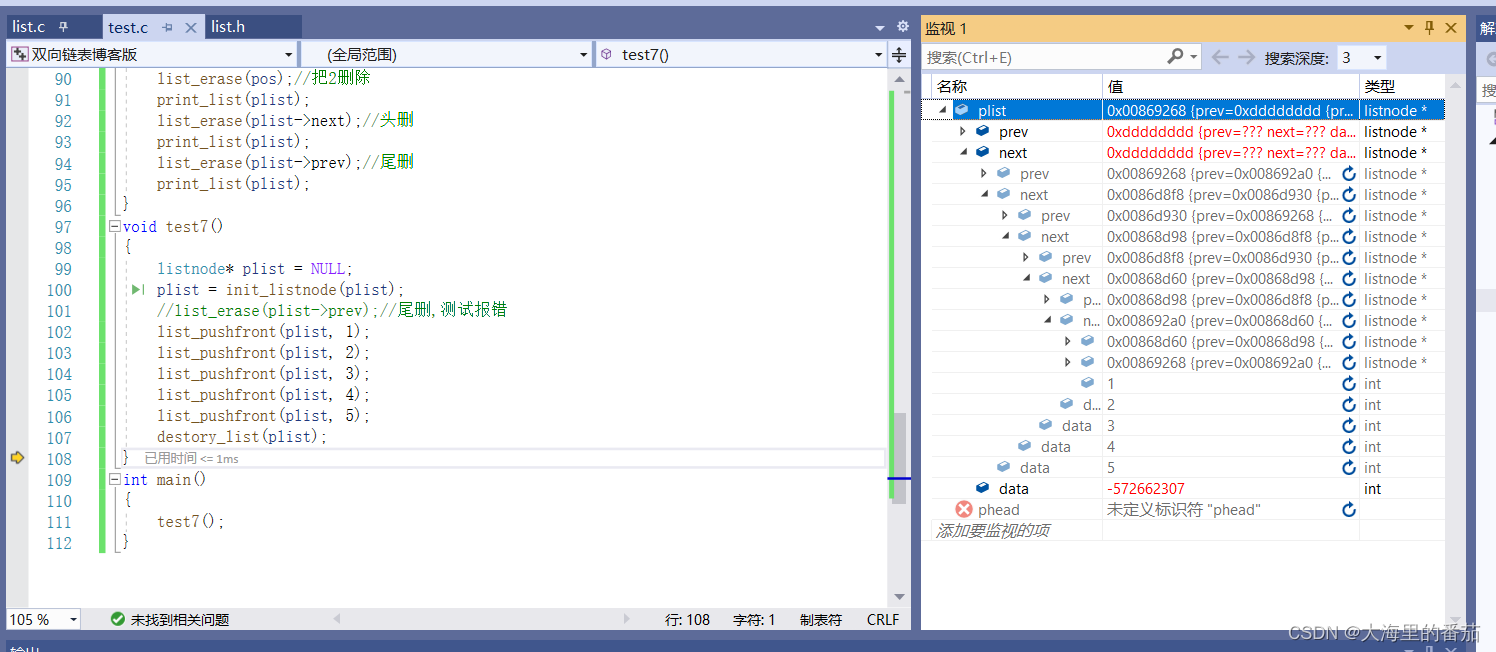
三、全部代码
1.接口头文件
#pragma once//防止头文件二次引用
#include<stdio.h>
#include<assert.h>
#include<stdlib.h>
typedef int LTDateType;
//这样创建结构体数据类型,不仅是为了和int做区分
//也是为了到时更好的替换,想换直接把int改了就行
typedef struct listnode
{
struct listnode* prev;//存放上一个节点的地址
struct listnode* next;//存放下一个节点的地址
LTDateType data;//该节点存放的数据
}listnode;
listnode* buy_listnode(LTDateType x);
listnode* init_listnode(listnode* phead);
void print_list(listnode* phead);
void list_pushback(listnode* phead, LTDateType x);
void list_pushfront(listnode* phead, LTDateType x);
void list_popfront(listnode* phead);
void list_popback(listnode* phead);
listnode* list_find(listnode* phead, LTDateType x);
void list_insert(listnode* pos, LTDateType x);
void list_erase(listnode* pos);
void destory_list(listnode* phead);2.接口实现
#define _CRT_SECURE_NO_WARNINGS 1
#include"list.h"
listnode* buy_listnode(LTDateType x)
{
listnode*newnode=(listnode*)malloc(sizeof(listnode));
if (newnode == NULL)
{
perror("buy_listnode");//错误提示
exit(-1);//节点都没创建出来,直接退出程序
}
newnode->data = x;//将新节点的数据初始化成我们需要的
newnode->next = NULL;//不清楚插入的方式,先初始化成空
newnode->prev = NULL;
}
listnode* init_listnode(listnode* phead)
{
phead = buy_listnode(-1); //-1是随便给的,初始化哨兵节点中的数据为-1,代表着没意义的数据
phead->next = phead;//初始化哨兵节点,自己指向自己
phead->prev = phead;
return phead;
}
void print_list(listnode* phead)
{
assert(phead);//哨兵节点地址不可能为空
listnode* head = phead->next;
//哨兵位节点不存储有效数据,因此phead->next才是头节点
printf("head<=>");//纯属美观
while (head != phead)//当head和phead相等意味着已经遍历完一遍链表
{
printf("%d<=>", head->data);
head = head->next;
}
printf("\n");
}
void list_pushback(listnode*phead,LTDateType x)
//尾插一个新节点,此节点存储x
{
listnode* newnode = buy_listnode(x);
//创建一个我们需要的新节点
listnode* tail = phead->prev;
//先找尾,尾很显然是哨兵位节点的上一个节点
tail->next = newnode;
newnode->prev = tail;
newnode->next = phead;
phead->prev = newnode;
}
void list_pushfront(listnode* phead, LTDateType x)
{
listnode* head = phead->next;//找到头节点
listnode* newnode = buy_listnode(x);//创建新节点
head->prev = newnode;
newnode->next = head;
phead->next = newnode;
newnode->prev = phead;
}
void list_popfront(listnode*phead)
{
assert(phead);
if (phead->next == phead)
{
printf("链表为空,操作失败\n");//为空就别删了
return;
}
listnode* head = phead->next;//找到头节点
phead->next = head->next;
head->next->prev = phead;
free(head);//链接完成,彻底删除
}
void list_popback(listnode*phead)
{
assert(phead);
if (phead->next == phead)
{
printf("链表为空,操作失败\n");//为空就别删了
return;
}
listnode* tail = phead->prev;//找到尾节点
phead->prev = tail->prev;
tail->prev->next = phead;
free(tail);
}
listnode* list_find(listnode* phead, LTDateType x)
//哨兵节点和目标
{
assert(phead);
listnode* head = phead->next;//找到头节点
while (head!=phead)//相等意味着已经遍历完了
{
if (head->data == x)
//找到目标,直接返回
{
return head;
}
head = head->next;
}
return NULL;//遍历完还找不到,返回空指针
}
void list_insert(listnode*pos,LTDateType x)
//目标位置,和在其前面插入数据为x的节点
{
if (pos == NULL)//传空意味着没找到目标
{
printf("目标不存在,操作失败\n");
return;
}
listnode*newnode=buy_listnode(x);//创建新节点
newnode->next = pos;
newnode->prev= pos->prev;
pos->prev->next = newnode;
pos->prev = newnode;
}
void list_erase(listnode* pos)
{
assert(pos && pos->next != pos);
pos->next->prev = pos->prev;
pos->prev->next = pos->next;
free(pos);
}
void destory_list(listnode* phead)
{
listnode* tail = phead->prev;
while (tail != phead)
{
listnode* tmp = tail;//存储尾
tail = tail->prev;//从后往前遍历
free(tmp);
//不需要管什么链接了,直接摧毁就行
}
free(phead);//单独摧毁
}3.测试文件
#define _CRT_SECURE_NO_WARNINGS 1
#include"list.h"
void test1()
{
listnode* plist=NULL;
plist=init_listnode(plist);
list_pushback(plist,1);
list_pushback(plist,2);
list_pushback(plist,3);
list_pushback(plist,4);
print_list(plist);
}
void test2()
{
listnode* plist = NULL;
plist = init_listnode(plist);
list_pushfront(plist, 1);
list_pushfront(plist, 2);
print_list(plist);
list_pushfront(plist, 10086);
print_list(plist);
}
void test3()
{
listnode* plist = NULL;
plist = init_listnode(plist);
list_pushfront(plist, 1);
list_pushfront(plist, 2);
print_list(plist);
list_pushfront(plist, 10086);
print_list(plist);
list_popfront(plist);
print_list(plist);
list_popfront(plist);
print_list(plist);
list_popfront(plist);
print_list(plist);
list_popfront(plist);
print_list(plist);
}
void test4()
{
listnode* plist = NULL;
plist = init_listnode(plist);
list_pushfront(plist, 1);
list_pushfront(plist, 2);
list_pushfront(plist, 10086);
print_list(plist);
list_popback(plist);
print_list(plist);
list_popback(plist);
print_list(plist);
list_popback(plist);
print_list(plist);
list_popback(plist);
print_list(plist);
}
void test5()
{
listnode* plist = NULL;
plist = init_listnode(plist);
list_pushfront(plist, 1);
list_pushfront(plist, 2);
list_pushfront(plist, 10086);
print_list(plist);
listnode*pos=list_find(plist,2);
list_insert(pos, 888);//在2之前插入888
print_list(plist);
list_insert(plist->next, 666);
//在头节点前插入666,与头插效用一致
//可以在头插中复用这个函数
print_list(plist);
list_insert(plist, 520);
//在哨兵节点前插入520,与尾插效用一致
//可以在尾插中复用这个函数
print_list(plist);
}
void test6()
{
listnode* plist = NULL;
plist = init_listnode(plist);
//list_erase(plist->prev);//尾删,测试报错
list_pushfront(plist, 1);
list_pushfront(plist, 2);
list_pushfront(plist, 3);
list_pushfront(plist, 4);
list_pushfront(plist, 5);
print_list(plist);
listnode* pos = list_find(plist, 2);
list_erase(pos);//把2删除
print_list(plist);
list_erase(plist->next);//头删
print_list(plist);
list_erase(plist->prev);//尾删
print_list(plist);
}
void test7()
{
listnode* plist = NULL;
plist = init_listnode(plist);
//list_erase(plist->prev);//尾删,测试报错
list_pushfront(plist, 1);
list_pushfront(plist, 2);
list_pushfront(plist, 3);
list_pushfront(plist, 4);
list_pushfront(plist, 5);
destory_list(plist);
}
int main()
{
test7();
}好了,今天的分享到这里就结束了,感谢各位友友来访,祝各位友友前程似锦O(∩_∩)O
